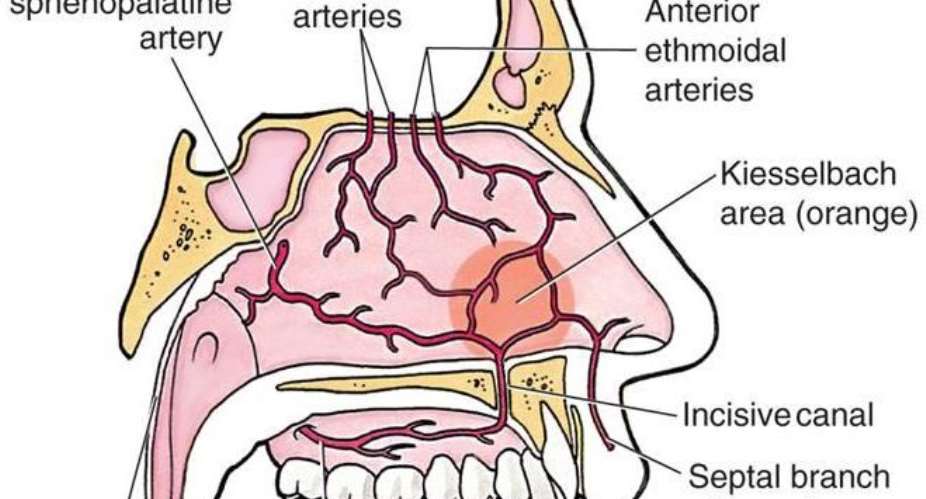NOSE BLEED, EPISTAXIS
Nosebleed is more common in a 2 to 10 year old kid, and in adults, aged 50 years and over.
Nosebleed is more common during dry weather conditions, such as the harmattan and winter periods.
Anatomy
The nasal septum has a rich supply of blood from several arteries: ethmoid, palatine ad sphenopalatine arteries.
The anterior and inferior part of the nasal septum (Little area or Kiesselbach area) has a dense blood supply but very thin mucosa. Trauma and dry air make this area, the commonest site (90%) for nose bleeds.
About 10% of nosebleeds are from the posterior middle turbinate, an area richly supplied with blood from the sphenopalatine artery.
Bleeding, usually, occurs from a single nostril. Blood may drip into the throat and stomach and affected persons may spit up or vomit blood.
CAUSES OF NOSE BLEED
Low environmental humidity, especially during the winter and harmattan period, have been associated with increased frequency of nosebleeds. Other conditions that obstruct normal airflow, including deviated nasal septum, lead to drying and irritation and hence recurrent nosebleed.
Blood coagulation defects, including platelets disorders may cause recurrent nosebleeds.
However, other causes of nosebleed include:
. Prolonged exposure to dry air
. Allergic Rhinitis
. Nose and sinus infection
. Sniffing cocaine
. Deviated or perforated nasal septum
. Foreign body in the nose
. Nose trauma.
EVALUATION
Routine blood work is unnecessary, unless the person shows signs of anemia, or has excessive blood loss. In such cases,
. A complete blood count.
. Prothrombin Time(PT) and Partial thromboplastin time (PTT)
. CT imaging if foreign body or sinusitis is suspected to be a cause.
MANAGEMENT OF NOSE BLEED
First Aid, At Home.
. Elevate the head.
. Pinch the nostril, using the first(index) and second fingers, for 15 minutes.
Bleeding normally stops at this point.
If bleeding does not stop,
. Gently blow the nose to remove clots, spray with topical decongestants (they shrink blood vessels in the nostils:
. Phenylephrine 0.25% or 0.5% (Neo-Synephrine, and Equate nasal sprays)
. Epinephrine 1:1000 nasal spray.
. Oxymetazoline 0.05% (Afrin nasal spray)
. Reapply pressure to the nose for 15 or more minutes.
Hospital management:
Doctors shall examine and identify the source of bleeding.
Doctors may then, burn-off the bleeding vessel with silver nitrate,
Doctors may then, pack the nasal passage with antibiotic impregnated vaseline strip gauze.
Packing remain in place for 4 to 5 days.
Other materials that stop nosebleed include:
. Vaseline strip gauze
. Oxycellulose sponges (Surgicel)
. Gelatin sponges (Gelfoam)
. Expandable nasal packs (RhinoRocket)
HOW TO PREVENT NOSEBLEED.
. During winter, harmattan and other dry weather conditions: saline nasal spray 4 to 5 times daily helps to moisten the nostrils.
. Those who habitually, pick their nose: must stop nose-picking, and trim their finger nails.
. Those with allergic rhinitis: may take daily antihistamines: loratadine 10mg, cetirizine 10mg and use steroid nasal spray. These agents reduce allergy symptoms and decreases the chance for nosebleed.
Topical bacitracin ointment applied to the nostrils, help decrease bacteria colonization, and this prevents recurrent nosebleeds.
. For those with sinus infections (Sinusitis): a course of Antibiotic helps to reduce recurrences.
Alex Sarkodie, MD.





 Lay KPMG audit report on SML-GRA contract before Parliament – Isaac Adongo tells...
Lay KPMG audit report on SML-GRA contract before Parliament – Isaac Adongo tells...
 Supervisor remanded for stabbing businessman with broken bottle and screwdriver
Supervisor remanded for stabbing businessman with broken bottle and screwdriver
 NDC watching EC and NPP closely on Returning Officer recruitment — Omane Boamah
NDC watching EC and NPP closely on Returning Officer recruitment — Omane Boamah
 Your decision to contest for president again is pathetic – Annoh-Dompreh blasts ...
Your decision to contest for president again is pathetic – Annoh-Dompreh blasts ...
 Election 2024: Security agencies ready to keep peace and secure the country — IG...
Election 2024: Security agencies ready to keep peace and secure the country — IG...
 People no longer place value in public basic schools; new uniforms, painting wil...
People no longer place value in public basic schools; new uniforms, painting wil...
 'Comedian' Paul Adom Otchere needs help – Sulemana Braimah
'Comedian' Paul Adom Otchere needs help – Sulemana Braimah
 Ejisu by-election: Only 33% of voters can be swayed by inducement — Global InfoA...
Ejisu by-election: Only 33% of voters can be swayed by inducement — Global InfoA...
 Minority will expose the beneficial owners of SML, recover funds paid to company...
Minority will expose the beneficial owners of SML, recover funds paid to company...
 Prof. Opoku-Agyemang has ‘decapitated’ the NPP’s strategies; don’t take them ser...
Prof. Opoku-Agyemang has ‘decapitated’ the NPP’s strategies; don’t take them ser...
